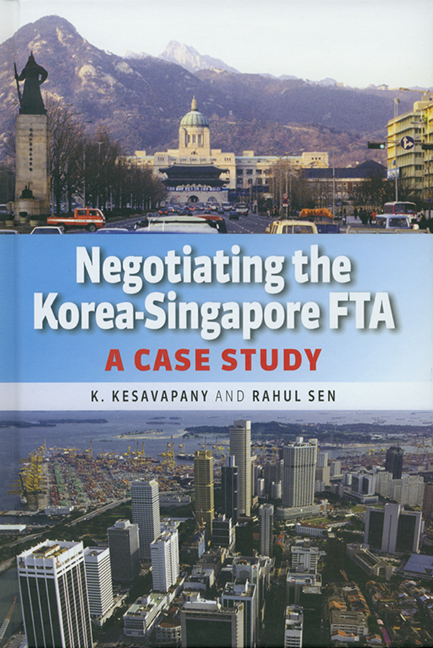Book contents
- Frontmatter
- Contents
- Foreword
- Preface
- 1 Background to the Korea-Singapore FTA
- 2 Singapore and Korea: Expanding Economic Linkages
- 3 Korea-Singapore Economic Relations After FTA: Towards a Mature Partnership
- 4 Salient Features of the KSFTA and Expected Benefits for Singapore
- 5 Singapore-Korea Business Linkages Post-KSFTA and Implementation
- 6 Concluding Remarks
- Notes
- References
- Appendix The Free Trade Agreement Between Korea and Singapore
Preface
Published online by Cambridge University Press: 21 October 2015
- Frontmatter
- Contents
- Foreword
- Preface
- 1 Background to the Korea-Singapore FTA
- 2 Singapore and Korea: Expanding Economic Linkages
- 3 Korea-Singapore Economic Relations After FTA: Towards a Mature Partnership
- 4 Salient Features of the KSFTA and Expected Benefits for Singapore
- 5 Singapore-Korea Business Linkages Post-KSFTA and Implementation
- 6 Concluding Remarks
- Notes
- References
- Appendix The Free Trade Agreement Between Korea and Singapore
Summary
Free Trade Agreements (FTAs) are viewed as superhighways that connect major economies and new markets. It is in the above context that Singapore has been engaged in negotiating bilateral Free Trade Agreements (FTAs) with its major trading partners who are “like minded” in terms of willingness to undertake comprehensive measures to liberalize trade and investment among themselves. Korea and Singapore, sharing the above vision on a variety of regional and international issues and having enjoyed strong political relations decided to embark on negotiations for a bilateral FTA in 2003. The conclusion of substantive negotiations of the Korea-Singapore Free Trade Agreement (KSFTA) was announced on 29 November 2004.
On 2 March 2006 Singapore's bilateral FTA with the Republic of Korea came into force. The Korea-Singapore FTA (KSFTA) is Korea's first comprehensive FTA involving any ASEAN member country and provides a framework for building a strong strategic and economic partnership between Korea and the ASEAN countries. It is therefore designed to be a building block in the process of community building efforts towards an East Asian Community in the long run.
The KSFTA is a comprehensive and highly substantive agreement, which is WTO-consistent in principles and WTO-plus in commitments. It aims to further enhance trade and investment flows between the two countries, bringing about a broadening and deepening of bilateral economic ties. The agreement covers diverse areas ranging from trade in goods, services and investments to that of competition policy, intellectual property protection, government procurement and other broad areas of economic cooperation. The book outlines the salient features of the agreement and the concrete benefits that would accrue to Singapore businesses and consumers from its use, in a range of areas beyond tariff reduction in trade in goods.
- Type
- Chapter
- Information
- Negotiating the Korea-Singapore FTAA Case Study, pp. ix - xPublisher: ISEAS–Yusof Ishak InstitutePrint publication year: 2007

